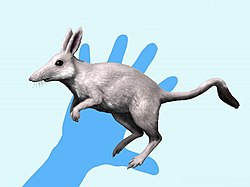| Prothylacinus | |
|---|---|
 | |
| Life restoration of P. patagonicus and Interatherium robustum | |
| Scientific classification | |
| Kingdom: | Animalia |
| Phylum: | Chordata |
| Class: | Mammalia |
| Order: | † Sparassodonta |
| Family: | † Prothylacinidae |
| Genus: | † Prothylacinus Ameghino, 1891 |
| Type species | |
| Prothylacinus patagonicus Ameghino, 1891 | |
| Synonyms | |
| |
Prothylacinus is an extinct genus of South American metatherian, that lived during the Early Miocene. [1]





